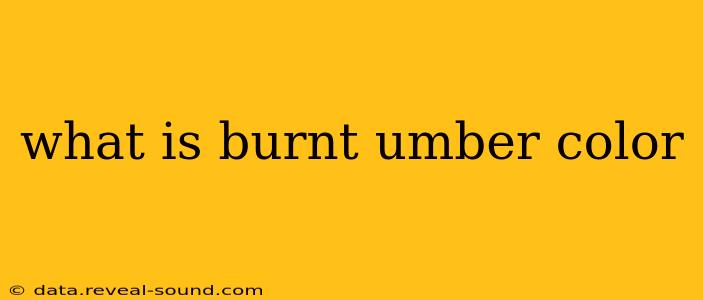Burnt umber is a naturally occurring dark brown pigment, prized by artists and designers for its rich, earthy tone and versatility. Understanding its characteristics goes beyond simply knowing its color; it involves appreciating its history, composition, and diverse applications. This deep dive explores everything you need to know about this captivating hue.
What Does Burnt Umber Look Like?
Burnt umber's color is a deep, warm brown, often described as a reddish-brown or a dark brownish-orange. It's a complex color, not a simple, flat brown, but one with subtle undertones and variations depending on the light and its application. Think of the color of rich, fertile soil after a rain, or the shade of dried leaves in autumn. The exact shade can vary slightly depending on the manufacturer and the specific process used to create the pigment.
What is Burnt Umber Made Of?
Traditionally, burnt umber is made from a naturally occurring earth pigment. This pigment is a mixture of iron oxides and manganese oxides. The "burnt" in its name refers to the process of heating raw umber (a yellowish-brown pigment), which alters its chemical composition and deepens its color to the characteristic dark brown. This heating process oxidizes the iron and manganese, resulting in a richer, more intense hue. Modern versions may sometimes include synthetic pigments to achieve consistency and cost-effectiveness.
How is Burnt Umber Different from Raw Umber?
The key difference between burnt umber and raw umber lies in their color and the production process. Raw umber is a yellowish-brown earth pigment, while burnt umber is a dark brown, reddish-brown, or brownish-orange, achieved by heating raw umber. Raw umber possesses a lighter, brighter tone, offering a different aesthetic quality in art and design.
What are the Differences in their Hues?
Raw umber features a lighter, more yellowish hue, often used to create base layers or lighter browns. Burnt umber, on the other hand, is significantly darker and warmer, providing depth and richness. This difference makes both pigments valuable tools for artists, allowing for a wider range of browns and earth tones in their work.
What are the Uses of Burnt Umber?
Burnt umber's versatility extends beyond the artist's palette. Its warm, earthy tones make it a popular color choice in:
- Painting: A staple in oil, watercolor, and acrylic painting, burnt umber creates depth, shadows, and rich mid-tones. It's used in glazing techniques and underpainting to build layers of color.
- Drawing: Burnt umber is used in pencil, pastel, and charcoal drawing for creating shading, texture, and depth.
- Interior Design: Burnt umber is frequently incorporated into interior design for wall colors, furniture, and accessories, creating a warm and inviting atmosphere. Its versatility allows for use in both rustic and modern styles.
- Textiles: Used as a dye for fabrics, burnt umber adds a natural, earthy tone to clothing and home décor.
- Cosmetics: While not as common, some cosmetics may use burnt umber as a pigment for creating certain shades of eyeshadow, bronzer, or lipstick.
Where Can I Find Burnt Umber?
Burnt umber pigment is widely available in art supply stores, both online and in physical locations. It's also found in many paint and home improvement stores, often as part of a wider range of earth tones. Look for it in various forms, including tubes, pans, and loose powder.
Is Burnt Umber Toxic?
While generally considered non-toxic in its dry form, like any pigment, ingestion should be avoided. Always follow safety precautions recommended by the manufacturer, especially if working with burnt umber in liquid forms or as a fine powder. Proper ventilation is advisable when using it, particularly in poorly ventilated spaces.
This comprehensive guide offers a thorough exploration of burnt umber, encompassing its visual characteristics, composition, uses, and safety considerations. Hopefully, this detailed information answers your questions about this versatile and captivating color.
